鲁科版(五四制) 小升初专题复习 感叹句、祈使句、There be课件(31张PPT)
文档属性
| 名称 | 鲁科版(五四制) 小升初专题复习 感叹句、祈使句、There be课件(31张PPT) | 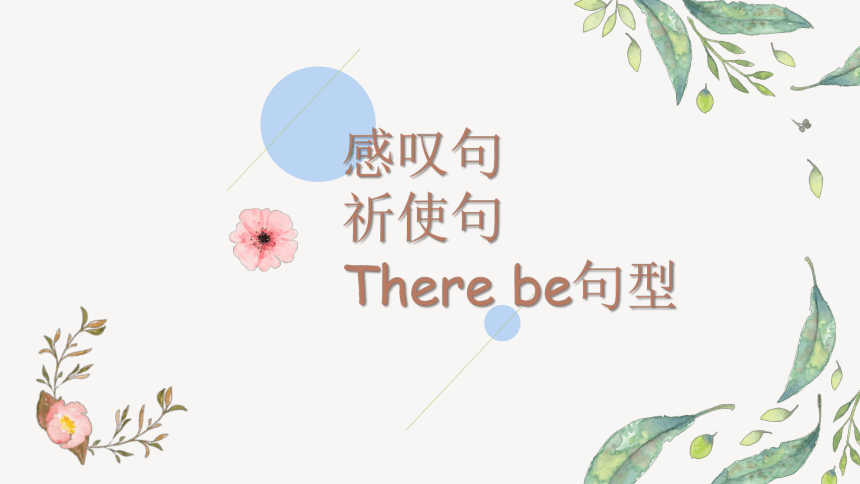 | |
| 格式 | pptx | ||
| 文件大小 | 23.6MB | ||
| 资源类型 | 教案 | ||
| 版本资源 | 鲁科版(五四制) | ||
| 科目 | 英语 | ||
| 更新时间 | 2023-09-12 19:21:44 | ||
图片预览

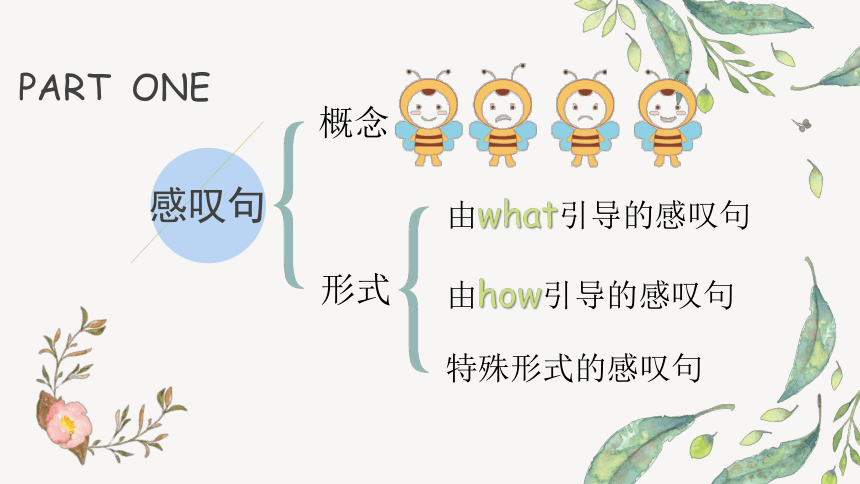

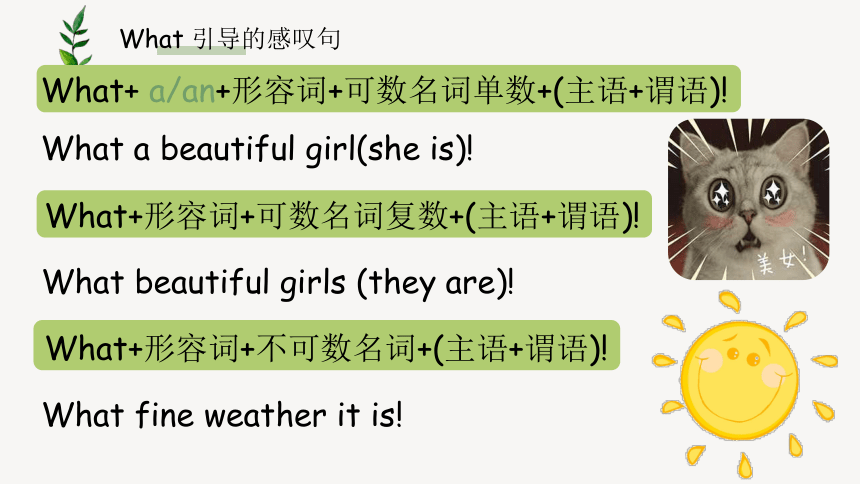
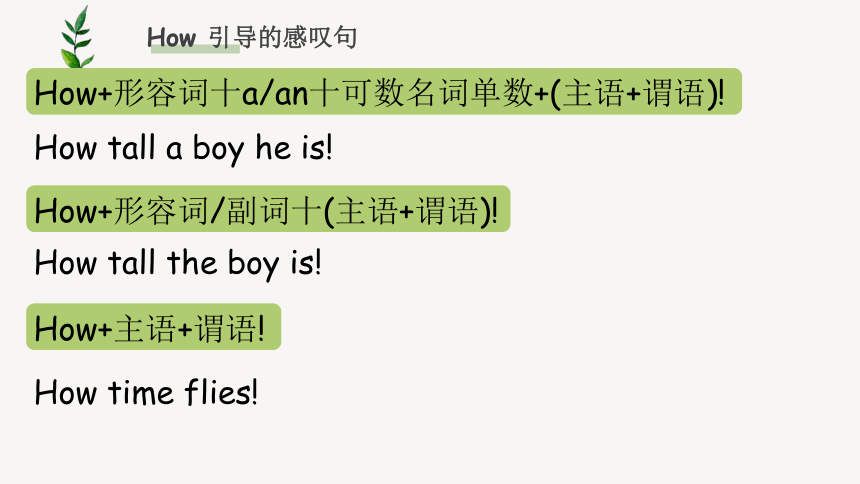
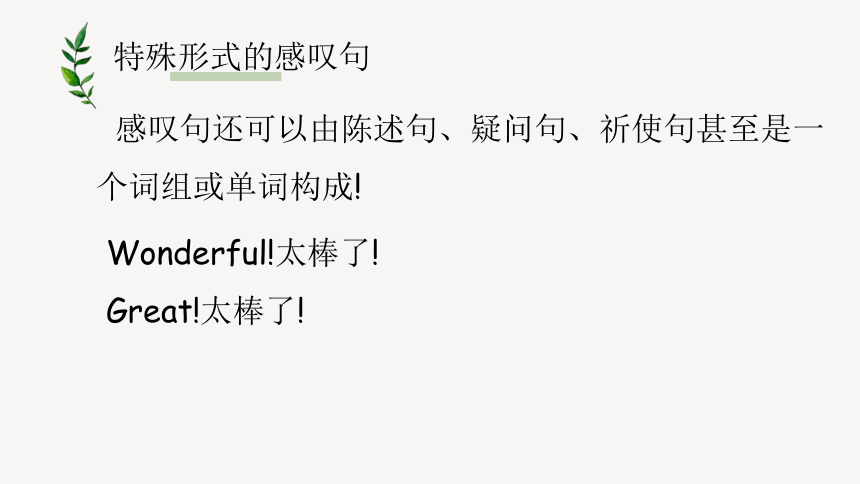
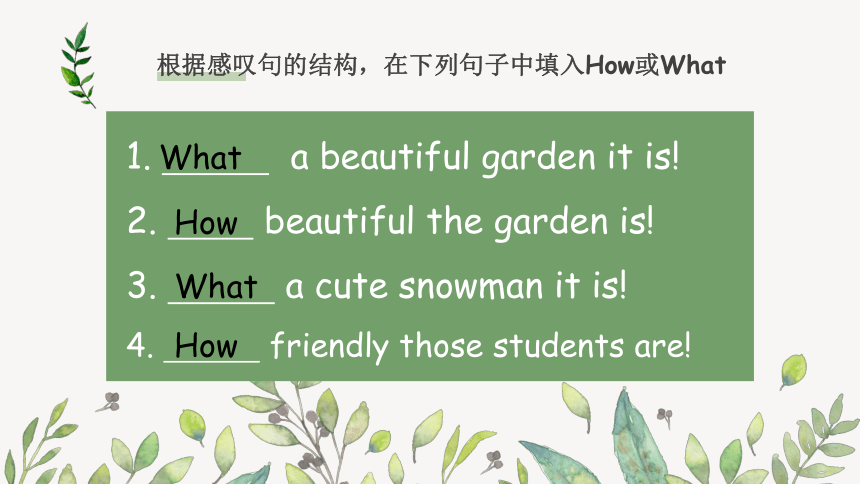
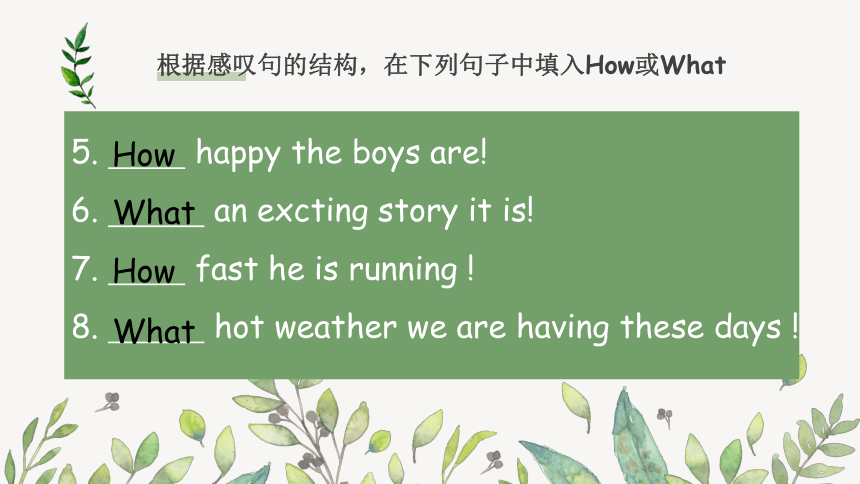
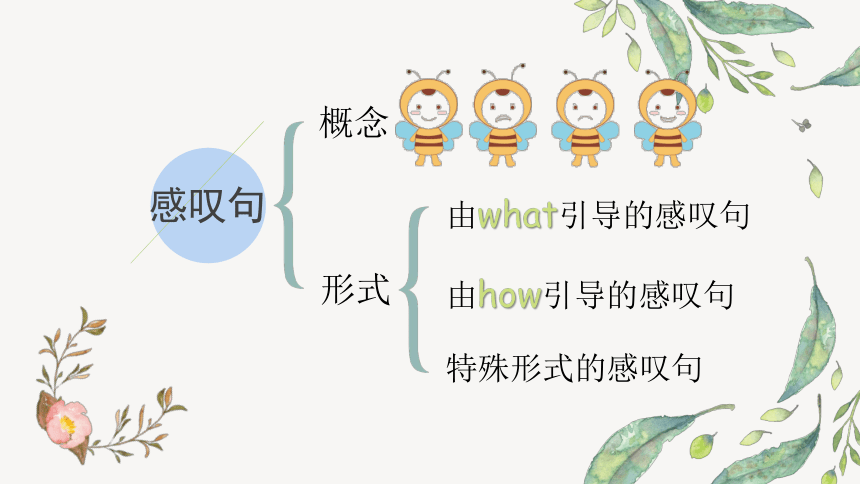
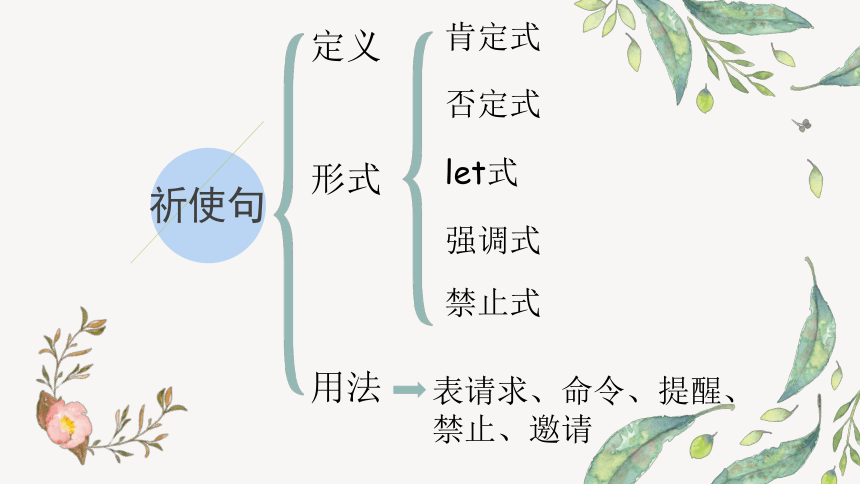
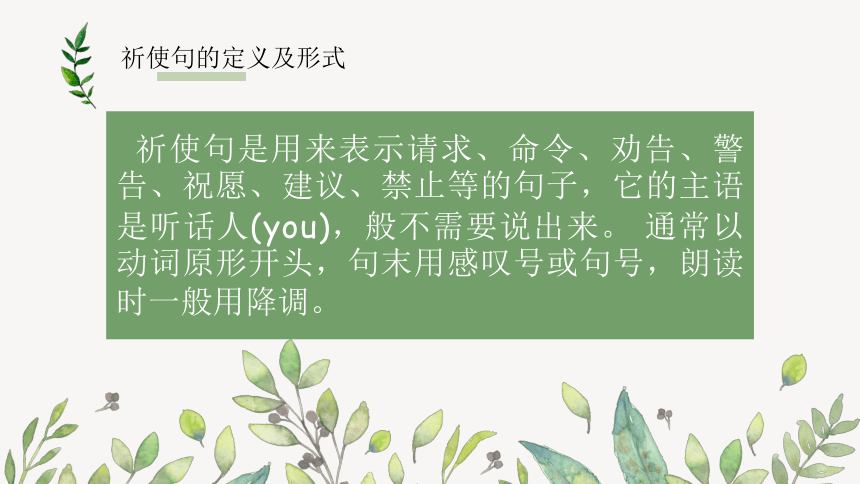
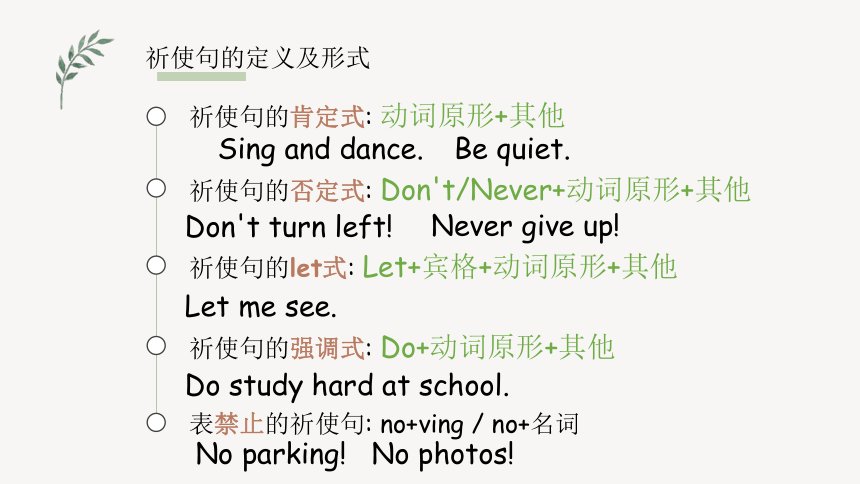
文档简介
感叹句
祈使句
There be句型
PART ONE
感叹句
概念
形式
由what引导的感叹句
由how引导的感叹句
感叹句的定义
感叹句表示说话人的喜、怒、哀、乐等强烈感情的句子,多用what或how引导。引导词(what/how)后加被强调的词,这些词可以是形容词、副词或名词,感叹句句末用感叹号,朗读时用降调。
How clever the monkey is!
What a beautiful building it is!
What+ a/an+形容词+可数名词单数+(主语+谓语)!
What a beautiful girl(she is)!
What+形容词+可数名词复数+(主语+谓语)!
What beautiful girls (they are)!
What+形容词+不可数名词+(主语+谓语)!
What fine weather it is!
How 引导的感叹句
How+形容词十a/an十可数名词单数+(主语+谓语)!
How tall a boy he is!
How+形容词/副词十(主语+谓语)!
How tall the boy is!
How+主语+谓语!
How time flies!
特殊形式的感叹句
感叹句还可以由陈述句、疑问句、祈使句甚至是一个词组或单词构成!
Wonderful!太棒了!
Great!太棒了!
根据感叹句的结构,在下列句子中填入How或What
1. a beautiful garden it is!
2. beautiful the garden is!
3. a cute snowman it is!
4. friendly those students are!
5. happy the boys are!
6. an excting story it is!
7. fast he is running !
8. hot weather we are having these days !
祈使句
定义
肯定式
形式
否定式
let式
强调式
禁止式
用法
表请求、命令、提醒、禁止、邀请
祈使句是用来表示请求、命令、劝告、警告、祝愿、建议、禁止等的句子,它的主语是听话人(you),般不需要说出来。 通常以动词原形开头,句末用感叹号或句号,朗读时一般用降调。
祈使句的肯定式: 动词原形+其他
Sing and dance.
祈使句的否定式: Don't/Never+动词原形+其他
Don't turn left!
Never give up!
Let me see.
祈使句的强调式: Do+动词原形+其他
Do study hard at school.
表禁止的祈使句: no+ving / no+名词
No parking!
No photos!
选择正确的词填空,把正确答案的代号填在横线上
A.No B.Be C. Den't D. Stop E. Let's F.Do
1. Please wait for me. walk so fast.
2. smoking.
3. talking , please.
4. a good boy.
5. go shopping.
6. be quick!
祈使句的用法
Stop talking!
Don't talk in class!
No photos!
No swimming!
Let's go to the beach!
Turn on the TV, please.
Please wait for us!
Be careful!
Look out! The car is coming.
Please join us!
Have some fruit!
There be句型又叫存在句,它是英语中一种常见的句型结构,表示“在某地存在某人或某物”。
结构:There be+名词+地点词(在何处)
There is a picture on the wall.
There are five apples on the desk.
There is a pen and twobooks in the bag.
句型特点:there无意义,be是谓语动词,与后面的名词在数上应保持一致。
There be结构的肯定式
There is+可数名词单数/不可数名词+地点。
There is a book on the desk.
There is some water in the bottle.
There are+可数名词复数+地点。
There are some flowers in the vase.
There be结构的否定式
There is/are not+名词+其他.
There is/are no+名词+其他.
There is no book on the desk.
There is not any water in the bottle.
There are not any flowers in the vase.
not any+可数名词复数/不可数名词
=no+可数名词复数/不可数名词
not a十可数名词单数
=no+可数名词单数
如果句中有some,变否定式时需将some变为any。
一般疑问句及其答语
—Is/ Are there+其他?
—Yes,there is/are. (No,there isn't/aren't.)
Is there a book on the desk?
Is there any water in the bottle?
Are there any flowers in the vase?
特殊疑问句及其回答
①提问句子的主语时,句型一律用:What is+地点?(无论主语是单数还是复数都用is)
There are some birds in the tree.
What's in the tree?
提问可数名词(主语)前的数量时,用how many,句型结构为:How many+复数名词+are there+其他?(主语无论是单数还是复数,be通常要用are)。
There are five apples on the desk.
→How many apples are there on the desk?
一般现在时用 is
There is a lake in the park.
There will be a sports meet next month.
There is going to be a party next week.
一般过去时用 was
There was a map on the wall.
在一般将来时情况下用will be/is going to be
当主语是不可数名词或单数可数名词时
There be结构中be的确定
当主语是可数名词复数时
一般现在时用 are
There are many trees in the garden.
一般过去时用 were
There were many trees in the garden.
一般将来时用 will be/are going to be
There will be many trees in the garden.
there is there are are there
is there there was there were
1.________ not any pandas in the forest.
2.________ anything interesting in the book?
3.________ an orange on the tree.
4.________ a meeting yesterday.
There (are/is) a book and three pens in my bag.
如果主语是一个由and连接的名词词组时,be动词应根据后面紧接的名词的数而定。
1.不同点
两者从汉语意思上来看都表示“有”的意思。
have(has)强调“拥有”,表示“某人或某物拥有”或“某人或某物本身具有”。如:
I have a pen.我有一支钢笔。(钢笔归我所有)
Do you have a sister?你有个妹妹吗?
There be强调“存在”,表示“某人或某物在某处”或“某地有某人或某物”。
There is a pen on the desk.在书桌上有支钢笔。
(钢笔在书桌上,但不归书桌所有)
There are many apples on the tree.
在树上有许多苹果。
虽然结构不同,但有时也可表达相似的意思。如:
Tom has two big apples in his hands.
=There are two big apples in Tom's hands.
The shop has many new shoes.
=There are many new shoes in the shop.
祈使句
There be句型
PART ONE
感叹句
概念
形式
由what引导的感叹句
由how引导的感叹句
感叹句的定义
感叹句表示说话人的喜、怒、哀、乐等强烈感情的句子,多用what或how引导。引导词(what/how)后加被强调的词,这些词可以是形容词、副词或名词,感叹句句末用感叹号,朗读时用降调。
How clever the monkey is!
What a beautiful building it is!
What+ a/an+形容词+可数名词单数+(主语+谓语)!
What a beautiful girl(she is)!
What+形容词+可数名词复数+(主语+谓语)!
What beautiful girls (they are)!
What+形容词+不可数名词+(主语+谓语)!
What fine weather it is!
How 引导的感叹句
How+形容词十a/an十可数名词单数+(主语+谓语)!
How tall a boy he is!
How+形容词/副词十(主语+谓语)!
How tall the boy is!
How+主语+谓语!
How time flies!
特殊形式的感叹句
感叹句还可以由陈述句、疑问句、祈使句甚至是一个词组或单词构成!
Wonderful!太棒了!
Great!太棒了!
根据感叹句的结构,在下列句子中填入How或What
1. a beautiful garden it is!
2. beautiful the garden is!
3. a cute snowman it is!
4. friendly those students are!
5. happy the boys are!
6. an excting story it is!
7. fast he is running !
8. hot weather we are having these days !
祈使句
定义
肯定式
形式
否定式
let式
强调式
禁止式
用法
表请求、命令、提醒、禁止、邀请
祈使句是用来表示请求、命令、劝告、警告、祝愿、建议、禁止等的句子,它的主语是听话人(you),般不需要说出来。 通常以动词原形开头,句末用感叹号或句号,朗读时一般用降调。
祈使句的肯定式: 动词原形+其他
Sing and dance.
祈使句的否定式: Don't/Never+动词原形+其他
Don't turn left!
Never give up!
Let me see.
祈使句的强调式: Do+动词原形+其他
Do study hard at school.
表禁止的祈使句: no+ving / no+名词
No parking!
No photos!
选择正确的词填空,把正确答案的代号填在横线上
A.No B.Be C. Den't D. Stop E. Let's F.Do
1. Please wait for me. walk so fast.
2. smoking.
3. talking , please.
4. a good boy.
5. go shopping.
6. be quick!
祈使句的用法
Stop talking!
Don't talk in class!
No photos!
No swimming!
Let's go to the beach!
Turn on the TV, please.
Please wait for us!
Be careful!
Look out! The car is coming.
Please join us!
Have some fruit!
There be句型又叫存在句,它是英语中一种常见的句型结构,表示“在某地存在某人或某物”。
结构:There be+名词+地点词(在何处)
There is a picture on the wall.
There are five apples on the desk.
There is a pen and twobooks in the bag.
句型特点:there无意义,be是谓语动词,与后面的名词在数上应保持一致。
There be结构的肯定式
There is+可数名词单数/不可数名词+地点。
There is a book on the desk.
There is some water in the bottle.
There are+可数名词复数+地点。
There are some flowers in the vase.
There be结构的否定式
There is/are not+名词+其他.
There is/are no+名词+其他.
There is no book on the desk.
There is not any water in the bottle.
There are not any flowers in the vase.
not any+可数名词复数/不可数名词
=no+可数名词复数/不可数名词
not a十可数名词单数
=no+可数名词单数
如果句中有some,变否定式时需将some变为any。
一般疑问句及其答语
—Is/ Are there+其他?
—Yes,there is/are. (No,there isn't/aren't.)
Is there a book on the desk?
Is there any water in the bottle?
Are there any flowers in the vase?
特殊疑问句及其回答
①提问句子的主语时,句型一律用:What is+地点?(无论主语是单数还是复数都用is)
There are some birds in the tree.
What's in the tree?
提问可数名词(主语)前的数量时,用how many,句型结构为:How many+复数名词+are there+其他?(主语无论是单数还是复数,be通常要用are)。
There are five apples on the desk.
→How many apples are there on the desk?
一般现在时用 is
There is a lake in the park.
There will be a sports meet next month.
There is going to be a party next week.
一般过去时用 was
There was a map on the wall.
在一般将来时情况下用will be/is going to be
当主语是不可数名词或单数可数名词时
There be结构中be的确定
当主语是可数名词复数时
一般现在时用 are
There are many trees in the garden.
一般过去时用 were
There were many trees in the garden.
一般将来时用 will be/are going to be
There will be many trees in the garden.
there is there are are there
is there there was there were
1.________ not any pandas in the forest.
2.________ anything interesting in the book?
3.________ an orange on the tree.
4.________ a meeting yesterday.
There (are/is) a book and three pens in my bag.
如果主语是一个由and连接的名词词组时,be动词应根据后面紧接的名词的数而定。
1.不同点
两者从汉语意思上来看都表示“有”的意思。
have(has)强调“拥有”,表示“某人或某物拥有”或“某人或某物本身具有”。如:
I have a pen.我有一支钢笔。(钢笔归我所有)
Do you have a sister?你有个妹妹吗?
There be强调“存在”,表示“某人或某物在某处”或“某地有某人或某物”。
There is a pen on the desk.在书桌上有支钢笔。
(钢笔在书桌上,但不归书桌所有)
There are many apples on the tree.
在树上有许多苹果。
虽然结构不同,但有时也可表达相似的意思。如:
Tom has two big apples in his hands.
=There are two big apples in Tom's hands.
The shop has many new shoes.
=There are many new shoes in the shop.
